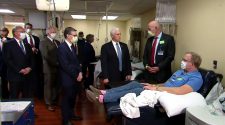The past 30 or so years have brought major changes to farm machinery. This will be most evident, to readers, in the scale of tractors and machines in fields and on rural roads. However, under the shiny metal skin of the machines is where the most significant changes have occurred.
Tuesday, 27th October 2020, 7:00 am
From the mid 1940s until around 1985, basic technology did not change a great deal. Tractors and implements were largely mechanical, relying on levers and hydraulics to control functionality and operation. The mid-1980s saw the introduction and rapid uptake of electronic consoles and switchgear in tractors, literally bringing finger-tip control and adjustment to many field operations. The era of precision farming was born.
Technologies introduced since the 1980s have majored on reducing unnecessary usage of fossil fuels, agri-chemicals and the over-working of soils. Machinery operated more efficiently, applying effort or inputs only where and when needed has been the key aim of most precision farming developments. My own interest in the field stretches back to the 1990s when I took over my family farm near Arbroath. I wanted to embrace technology to drive efficiency, I was also looking to lower our carbon footprint, before I even knew what a “carbon footprint” was!
I soon realised that some of the technology which I aspired to make use of was not available, perhaps not even invented. Conversations along these lines with a farming neighbour, Jim Wilson, established that he was of a similar mindset. In 2000 we established a business together, to source, supply and further develop precision farming technology, for our own farms and the wider farming community. Over the past 20 years the business we founded has grown into a cutting-edge success story. Our team have gone on to utilise developments from other sectors, including aerospace, and combine these with the inherent knowledge of agriculture in our growing customer base, to produce innovative new precision farming innovations.
Just this year, we have launched a new app – Tuberzone Cropcast – which can help growers predict precisely when potatoes are ready to harvest to produce the exact specification of tattie demanded by the market. This reduces the need for repeated expensive and wasteful test digs and was trialled and proven thanks to collaborative working between us and 29 farmers working under the Grampian Growers co-operative and the hard work of scientists from Scotland’s Rural College.
The technologies that we, and other firms like us, are developing and introducing enables farmers to make better use of resources and operate in a more environmentally and financially sustainable manner. We can take geo-referenced soil samples, map crop yield, soil texture, satellite and drone images and create maps used by growers to fine tune their crop performance and inputs. We can supply cultivators utilising cutting edge camera and robotic technology to hoe out weeds without damaging the crop or relying on herbicides. We can install pin-point accurate GPS into tractors to ensure that no fuel is wasted, precious soil unnecessarily cultivated or compacted, and every seed is placed exactly where it should be.
I am proud that our firm is at the cutting edge of precision farming – the new green revolution.
Robert Ramsay is Commercialisation Director of SoilEssentials, based in Angus.














